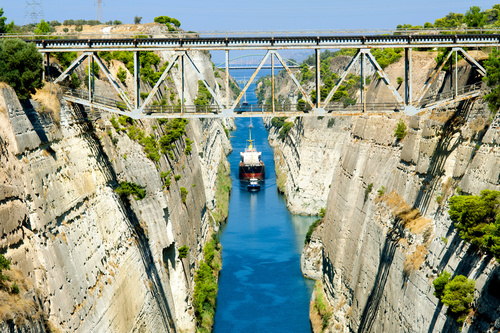
JOURNEY TO ANCIENT CORINTH
Half Day Tour of Ancient CorinthDrive westwards along the scenic coast, until we reach the Corinth Canal with its breathtaking views (short stop). Thereafter we reach the Ancient Town of Corinth (visit) where St Paul lived and preached for two years. Back in the ancients times Corinth was amongst the richest cities and this is quite evident by its remains, including the huge agora (market place) and Apollo’s Temple (6th c.B.C) brief stop at the site of the ancient port Kenchreai where St Paul disembarked. Return to Athens
Ancient Corinth is open: In winter :8am-3pm In Summer: 8am-5pm Ancient Corinth entrance ticket: 7euros*

Closed on Holidays: Jan 1st, March 25th, May 1st,Oct 28th, Christmas and Boxing Day. Good Friday: open from 12noon to 3pm. Holy Saturday: 08.30-3pm Easter Sunday: closed Easter Monday: 08.30-3pm
*Students of non European Union countries holders of an international student card are entitled to 50% discount on the entrance fee. Young people up the age of 18 are entitled to free admission. European Union students are entitled to free entrance while European Union senior citizens over 65 have 50% discount on entry to all Greek museums and archaeological sites.
Free admission days : 6 March, 5 June , 18 April, 18 May , The last weekend of September annually , Sundays in the period between 1 November and 31 March, The first Sunday of every month, except for July, August and September 27 September, International Tourism Day
Corinth (/ˈkɔrɪnθ/; Greek: Κόρινθος Kórinthos), was a city-state (polis) on the Isthmus of Corinth, the narrow stretch of land that joins the Peloponnesus to the mainland of Greece, roughly halfway between Athens and Sparta. The modern town of Corinth is located approximately 5 kilometres (3.1 mi) northeast of the ancient ruins. Since 1896, systematic archaeological investigations of the Corinth Excavations by the American School of Classical Studies at Athens have revealed large parts of the ancient city, and recent excavations conducted by the Greek Ministry of Culture have brought important new facets of antiquity to light. For Christians, Corinth is known from the two books First Corinthians and Second Corinthians in the New Testament. The 2nd book of Pausanias’ Description of Greece is devoted to Corinth. Ancient Corinth was one of the largest and most important cities of Greece, with a population of 90,000 in 400 BC. After the Romans built a new city in its place and made it the provincial capital of Greece in 44 BC, the city’s population was between 50,000 to 700,000 according to different sources.
The prefecture’s capital is the region’s prominent administrative, commercial, financial and cultural centre. The city centre has wide roads, parks, squares and a picturesque port with fishing boats. Beautiful pedestrian walkways entice the visitors for a stroll, a coffee and shopping, with monuments, museums and historical sites surrounding the city.
The settlement dating to 5000 B.C that was discovered in the Korakos region is testament to Korinthos’ habitation since the Neolithic Age. In antiquity Korinthos was one of the largest and most important cities in Greece. It played a significant part during the Peloponnesian War and after 200 B.C it became the capital of the Achaean Confederation. Under Julius Caesar it was elevated to the capital of the Achaia province. During the middle Ages it was associated with its impressive fortifications at Akrokorinthos (Acrocorinth). A powerful earthquake destroyed the city in 1858, which was rebuilt with good earthquake resistant specifications on a good town plan, 9 km to the north of the ancient city. The charming town of Palaia Korinthos is situated on the site of Ancient Korinthos. Korinthos is 84 km to the west of Athens.
Must see attractions
– The seaside zone, especially around the El. Venizelos square with the impressive statue of Pegasus and the small port of Floisvos with the marina. Close by, you will find Kalamia, an extensive and established pebble strewn beach, with many coffee shops and taverns all along it.
– The pedestrian walkway on Pilarinos Zografos Street is a much frequented meeting place for the residents with stores, coffee shops and bars.
– The central Perivolakia square – park with the coffee shops and restaurants is the ideal location for stopping and resting. Across the road (on Ethnikis Antistasis Street) is the city’s impressive Court House, while the statue of Archbishop Damascenus (1890-1949) stands at the small square precisely in front of the Courts.
– The Apostolos Pavlos (Apostle Paul) metropolitan church, on the street of the same name, which was built after the 1928 earthquakes. The “Apostle to the Nations” lived and taught here for a short period and is the city’s patron saint.
– The Historic-Folklore Museum (close to the El. Venizelos square), with exhibits of 3,500 18th and 19th century costumes from all over Greece.
– The Ecclesiastical Museum was established in 1973 and contains significant ecclesiastical exhibits (manuscripts, high priest vestments, portable icons, gospels, photographs etc).
– The Municipal lending Library (84 Pilarinos Street), with notable collections and the Municipal Art Gallery (4 Kolokotroni Street).
Near-by destinations
– The archaeological site of Ancient Korinthos is 9 km north-west of the modern city. You can see the ruins at Pirini fountain, the courtyard of Apollo, the foundations of a significant Roman basilica, the temple of the goddess Tyche (Fortune) or Apollo Klarios, the stores in the agora, the temple of Apollo, the ruins of the theatre and the Lerna fountain. The town of Acrocorinth, at whose foot the ancient city was built, dates to circa 4000 B.C. The Archaeological Museum operates at the archaeological site (built in 1931-32) with an exhibition collection dating from the Prehistoric Period through to the Roman and Byzantine Period. It is worth seeing the large Mycenaean crater (vessel) (circa 1200 B.C.), the Corinthian amphora and stopper (600 B.C.) etc

– Acrocorinth (the residence of the Sun God!), 3.5 km south of ancient Korinthos, at the peak of a 575 m high hill, has always been the fortified acropolis of Korinthos. It is the oldest, largest and most impressive castle in the Peloponnese, whose walls were built during the middle Ages. It is worth seeing the ruins at the temple of Aphrodite, and the relics of the Christian Churches and the Turkish buildings, on the peak of the hill. In addition to its archaeological significance, Acrocorinth is a rich botanical garden with numerous indigenous Greek wild flowers and belongs to the “Natura 2000” European Union habitat network. On the opposite hill (Penteskoufi) there is a smaller medieval castle (13th century), which is however difficult to access.
– The Corinthian Canal: the idea for the canal, which connects the Saronic to the Corinthian gulf, was conceived by Periander (6th century B.C.); however, the canal was finally opened after Greece’s independence, during the period 1882-1893. It has a length of 6,346 metres, a width of 24.6 metres at sea level and a depth of 8 metres.
– Possidonia (on the western side of the canal, close to the Corinthian gulf), where you can see the Ancient Passage Way (Diolkos). It is a paved road that was constructed due to the need for rapid passage by ships from the Saronic to the Corinthian gulf and vice versa. It was constructed in the early 6th century B.C. and is associated with Periander’s tyranny in Korinthos. Its western edge was reconstructed in the early 4th century B.C. It was used to transport small (especially military) vessels. This use has been attested by sources down to the 9th century A.D.
– Lechaio is a beautiful seaside town, 8 km to the west of Korinthos. The region was developed in the 6th century B.C, since Lechaio – together with Keghrees – were the city’s two ports. The ruins of the ancient port have survived to the present day. Excavations have uncovered the ruins of a palaeo-Christian basilica, to the west of the ancient port, which was constructed in the 5th century A.D in honour of the martyr Leonidis and the seven Virgins who martyred during the Decian persecution in 251 A.D. The church of Agios Gerasimos is also situated at Lechaio where Gerasimos Notaras was a hermit. There is a fertile valley in the wider region, where fruit and grape vines are cultivated.
FULL DAY CORINTHOS
Includes: The Corinth Canal – Temple of Apollo – Ancient Corinth – Lunch at the seaside town of Loutraki
Duration: 6 hours
Cost:200 euros pickup from Athens City Center or Piraeus port, 260 euros pickup from Athens airport





Leave a Reply